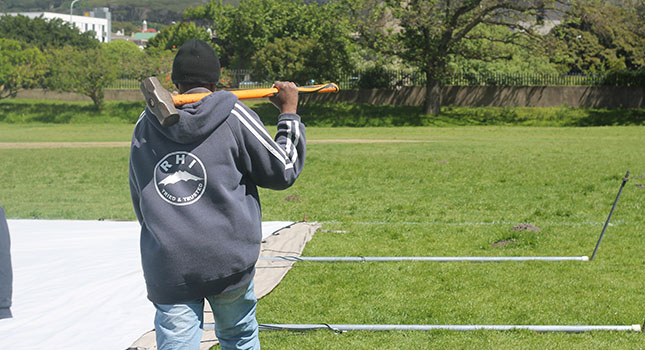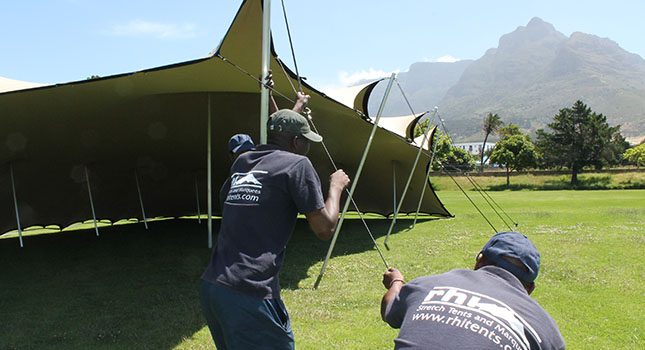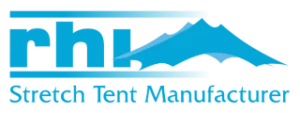As a stretch tent manufacturer that complies with international safety regulations, we recommend that our tent rental partners, too, follow the minimum safety guidelines when erecting and dismantling a temporary stretch tent structure.
Our commitment to safety is especially important when taking into account that we supply tents to various countries around the world, predominantly in Europe (United Kingdom, Germany, Belgium, France, Spain), that operate under their own unique health and safety executives.
Generally speaking, contractors affiliated with RHI provide services on a short-term or temporary hire basis (less than 28 days). Long-term or semi-permanent installations may be subject to regulations not covered in this guide.
Who is this guide for?
- Stretch tent rental companies (contractors)
- Event organisers and venue owners
Introduction
Prior to an event, the stretch tent contractor needs to define the respective areas of (health and safety) responsibilities between him or her and the event organiser or venue owner. This aspect is normally standard throughout the industry and set out in the contract between the contractor and event organiser.
It is the contractors’ sales staff’s responsibility to make the client aware of his or her responsibilities.
The erection of a temporary structure is ultimately put to the test in the case of fire or adverse weather conditions. Procedures need to be in place to safeguard event-goers and staff if a fire were to break out, or if wind speeds were to unexpectedly increase.
Which brings us to the first part of this guide: Inspections.
Part 1: Inspections

The first part of this guide explains how to do a thorough inspection before and after setup.
The inspection process
- Examination of stretch tent components.
- Checklist inspection upon completed assembly.
- Inspection before handover to client.
1. Examination of the stretch tent components
Fundamental to stretch tent safety is ensuring that the tent itself and all rigging components are maintained on an ongoing basis and are in good working condition. The stretch tent rental industry is seasonal of nature, and, as such, the off-season is used for inspecting, repairing and refurbishing equipment.
Special attention should be paid to the components that are critical to the structure of the stretch tent. It is also advised that records be kept of such inspections and of any repairs or maintenance carried out to critical components.
2. Checklist inspection upon completed assembly
This inspection should be conducted by the head rigger.
- Check ropes for fraying; ropes with more than 20% fraying should be replaced.
- Check tent membranes for tears and repair in accordance to the manufacturer’s recommendations.
- Check lugs and patches and repair in accordance with the manufacturer’s recommendations.
- Check seams of the tent membranes and repair in accordance with the manufacturer’s recommendations.
- Check stakes/ pegs to ensure they’re straight.
- Check poles for kinking or bowing.
3. Inspection before handover to client
Before the erection is signed off and handed over to the client, it should undergo a thorough inspection.
Once done, a report can be issued that will incorporate a checklist carried out by the head rigger.
The head rigger, who acts in a supervisory capacity, should have training in or be thoroughly familiar with the particular structure type and size.
- All aspects of the final structure are at a safe distance from power lines and other possible hazards.
- Anchorages are suitable for the purpose and soil condition and are holding fast.
- All anchorages are fitted with a protector.
- All ropes are sound.
- The tent is properly tensioned and not prone to ponding in rainy weather.
- Emergency exits are in place, operating correctly and are without obstruction.
- Escape routes are clear of obstruction.
- Exposed ropes and stakes adjacent to exits and entrances are marked and/or roped off.
- All structural supports are sound without cracks or significant dents and not overstressed.
- All wooden uprights (if used) are free from splits that are likely to cause failure.
- No fabric tears are present.
- The main center uprights are straight and sound.
- Final all-round visual check to satisfy that the tent is securely erected.
Part 2: Stability

Stretch tent structures should be able to completely close when they’re not in use, also when extreme weather conditions are expected. Raising and lowering the sides of a stretch tent is something that can only be carried out by the contractor. If the sides are raised then the contractor must have the required systems in place to continuously assess wind conditions at the site and must take preventative action to lower the sides if necessary.
Considerations
- Clients should be informed of the design wind load of the stretch tent and provide instructions for evacuation should this be reached. A wind monitoring plan that incorporates wind action levels should be developed and provided to the client.
- Roof panels/ canopies should be sufficiently tensioned to avoid ponding.
- When there is a chance of snow, clients should be advised of the requirement to heat the structure to prevent snow build-up which could endanger the structure’s stability. This is a particular danger where adjacent structures form a valley. In saying that, rigging a stretch tent should be avoided when snow is expected.
- Continual reference should be made to weather forecasting services, especially when stretch tent structures are erected during winter or on exposed sites. With more complex structures, on-site wind monitoring devices should supplement information from remote weather forecasting services.
- If fabric structures cannot be protected or strengthened to withstand the forecasted wind speeds, they should be made safe by lowering or removing the covers, which can be reinstated when winds have died down. In carrying out these measures, no member of the public or work crew should be put at risk.
- It is the stretch tent contractor’s responsibility to agree with the client at the outset what surveillance/ maintenance will be required after the fabric structure has been handed over. This determination should be made on the basis of a risk assessment which takes all relevant factors into account, including the use to which the structure is put, the security of the structure, the weather conditions, time of year, and so on.
- The contractor should provide the client with an “after- hours” emergency telephone number(s).
Part 3: Client Communication

The stretch tent contractor should make the client aware of the following factors when considering a site and using a stretch tent structure.
Considerations
- No dangerous, combustible or toxic gases or other allied product such as aerosols, explosives or pyrotechnics should be stored within a fabric structure.
- To prevent the risk of fire, the client should ensure that the grass and vegetation within the footprint of the fabric structure have been cut and clippings removed prior to setup. This includes an adequate working area around the footprint and the access route to and from it (including emergency access)
- The site should be a reasonable distance from over-ground services, like overhead power lines, and the client should provide information to the contractor prior to installation of the location of underground services as stretch tents generally require pegging of at least one meter in length.
- Stretch tent structures don’t have snow-load capacity, so if snow is a possibility the structure must be heated in order to maintain a minimum temperature of 12ºC to prevent build-up of snow on the roof. ‘Valleys’ between stretch tents or buildings can be a particular problem when snow builds up and clients should be made aware of the danger and the need to remove excess weight from the roof.
- Persons other than the contractor’s staff or those under their supervision should not be admitted to a fabric structure during erection or dismantling.
- Exit routes should be kept free from obstruction at all times.
- When any person is inside the stretch tent, the exit doors should not be securely closed.
- The client should be informed of maximum design wind load.
- Ongoing reference should be made to weather forecasting services, particularly in winter or if the tent is erected on an exposed site. Contingency plans should be in place to evacuate the tent in the event that wind speeds should approach the maximum service gust speed.
- The client should be made aware that, once the structure has been handed over, it is essential that they make no modifications to it, in particular, structural components or the number and positioning of exits. These changes can only be made by the contractor.
